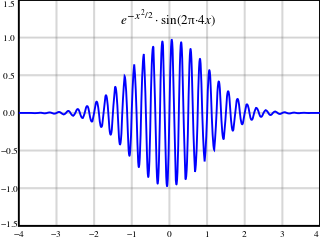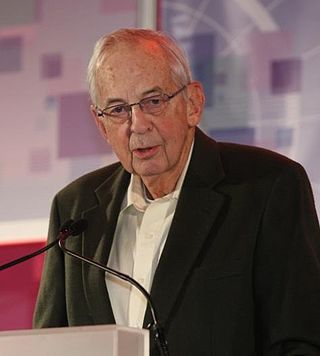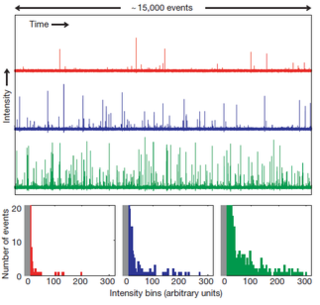Related Research Articles
Mode locking is a technique in optics by which a laser can be made to produce pulses of light of extremely short duration, on the order of picoseconds (10−12 s) or femtoseconds (10−15 s). A laser operated in this way is sometimes referred to as a femtosecond laser, for example, in modern refractive surgery. The basis of the technique is to induce a fixed phase relationship between the longitudinal modes of the laser's resonant cavity. Constructive interference between these modes can cause the laser light to be produced as a train of pulses. The laser is then said to be "phase-locked" or "mode-locked".
Four-wave mixing (FWM) is an intermodulation phenomenon in nonlinear optics, whereby interactions between two or three wavelengths produce two or one new wavelengths. It is similar to the third-order intercept point in electrical systems. Four-wave mixing can be compared to the intermodulation distortion in standard electrical systems. It is a parametric nonlinear process, in that the energy of the incoming photons is conserved. FWM is a phase-sensitive process, in that the efficiency of the process is strongly affected by phase matching conditions.

An optical microcavity or microresonator is a structure formed by reflecting faces on the two sides of a spacer layer or optical medium, or by wrapping a waveguide in a circular fashion to form a ring. The former type is a standing wave cavity, and the latter is a traveling wave cavity. The name microcavity stems from the fact that it is often only a few micrometers thick, the spacer layer sometimes even in the nanometer range. As with common lasers, this forms an optical cavity or optical resonator, allowing a standing wave to form inside the spacer layer or a traveling wave that goes around in the ring.

An optical parametric oscillator (OPO) is a parametric oscillator that oscillates at optical frequencies. It converts an input laser wave with frequency into two output waves of lower frequency by means of second-order nonlinear optical interaction. The sum of the output waves' frequencies is equal to the input wave frequency: . For historical reasons, the two output waves are called "signal" and "idler", where the output wave with higher frequency is the "signal". A special case is the degenerate OPO, when the output frequency is one-half the pump frequency, , which can result in half-harmonic generation when signal and idler have the same polarization.
A fiber laser is a laser in which the active gain medium is an optical fiber doped with rare-earth elements such as erbium, ytterbium, neodymium, dysprosium, praseodymium, thulium and holmium. They are related to doped fiber amplifiers, which provide light amplification without lasing.

A frequency comb or spectral comb is a spectrum made of discrete and regularly spaced spectral lines. In optics, a frequency comb can be generated by certain laser sources.
In numerical analysis, the split-step (Fourier) method is a pseudo-spectral numerical method used to solve nonlinear partial differential equations like the nonlinear Schrödinger equation. The name arises for two reasons. First, the method relies on computing the solution in small steps, and treating the linear and the nonlinear steps separately. Second, it is necessary to Fourier transform back and forth because the linear step is made in the frequency domain while the nonlinear step is made in the time domain.
Silicon photonics is the study and application of photonic systems which use silicon as an optical medium. The silicon is usually patterned with sub-micrometre precision, into microphotonic components. These operate in the infrared, most commonly at the 1.55 micrometre wavelength used by most fiber optic telecommunication systems. The silicon typically lies on top of a layer of silica in what is known as silicon on insulator (SOI).

In optics, a supercontinuum is formed when a collection of nonlinear processes act together upon a pump beam in order to cause severe spectral broadening of the original pump beam, for example using a microstructured optical fiber. The result is a smooth spectral continuum. There is no consensus on how much broadening constitutes a supercontinuum; however researchers have published work claiming as little as 60 nm of broadening as a supercontinuum. There is also no agreement on the spectral flatness required to define the bandwidth of the source, with authors using anything from 5 dB to 40 dB or more. In addition the term supercontinuum itself did not gain widespread acceptance until this century, with many authors using alternative phrases to describe their continua during the 1970s, 1980s and 1990s.
In physical optics or wave optics, a vector soliton is a solitary wave with multiple components coupled together that maintains its shape during propagation. Ordinary solitons maintain their shape but have effectively only one (scalar) polarization component, while vector solitons have two distinct polarization components. Among all the types of solitons, optical vector solitons draw the most attention due to their wide range of applications, particularly in generating ultrafast pulses and light control technology. Optical vector solitons can be classified into temporal vector solitons and spatial vector solitons. During the propagation of both temporal solitons and spatial solitons, despite being in a medium with birefringence, the orthogonal polarizations can copropagate as one unit without splitting due to the strong cross-phase modulation and coherent energy exchange between the two polarizations of the vector soliton which may induce intensity differences between these two polarizations. Thus vector solitons are no longer linearly polarized but rather elliptically polarized.
In physics, the exciton–polariton is a type of polariton; a hybrid light and matter quasiparticle arising from the strong coupling of the electromagnetic dipolar oscillations of excitons and photons. Because light excitations are observed classically as photons, which are massless particles, they do not therefore have mass, like a physical particle. This property makes them a quasiparticle.

James Power Gordon was an American physicist known for his work in the fields of optics and quantum electronics. His contributions include the design, analysis and construction of the first maser in 1954 as a doctoral student at Columbia University under the supervision of C. H. Townes, development of the quantal equivalent of Shannon's information capacity formula in 1962, development of the theory for the diffusion of atoms in an optical trap in 1980, and the discovery of what is now known as the Gordon-Haus effect in soliton transmission, together with H. A. Haus in 1986. Gordon was a member of the National Academy of Engineering and the National Academy of Sciences.

Optical rogue waves are rare pulses of light analogous to rogue or freak ocean waves. The term optical rogue waves was coined to describe rare pulses of broadband light arising during the process of supercontinuum generation—a noise-sensitive nonlinear process in which extremely broadband radiation is generated from a narrowband input waveform—in nonlinear optical fiber. In this context, optical rogue waves are characterized by an anomalous surplus in energy at particular wavelengths or an unexpected peak power. These anomalous events have been shown to follow heavy-tailed statistics, also known as L-shaped statistics, fat-tailed statistics, or extreme-value statistics. These probability distributions are characterized by long tails: large outliers occur rarely, yet much more frequently than expected from Gaussian statistics and intuition. Such distributions also describe the probabilities of freak ocean waves and various phenomena in both the man-made and natural worlds. Despite their infrequency, rare events wield significant influence in many systems. Aside from the statistical similarities, light waves traveling in optical fibers are known to obey the similar mathematics as water waves traveling in the open ocean, supporting the analogy between oceanic rogue waves and their optical counterparts. More generally, research has exposed a number of different analogies between extreme events in optics and hydrodynamic systems. A key practical difference is that most optical experiments can be done with a table-top apparatus, offer a high degree of experimental control, and allow data to be acquired extremely rapidly. Consequently, optical rogue waves are attractive for experimental and theoretical research and have become a highly studied phenomenon. The particulars of the analogy between extreme waves in optics and hydrodynamics may vary depending on the context, but the existence of rare events and extreme statistics in wave-related phenomena are common ground.

Roberto Morandotti is a physicist and full Professor, working in the Energy Materials Telecommunications Department of the Institut National de la Recherche Scientifique. The work of his team includes the areas of integrated and quantum photonics, nonlinear and singular optics, as well as terahertz photonics.

Luigi Lugiato is an Italian physicist and professor emeritus at University of Insubria (Varese/Como). He is best known for his work in theoretical nonlinear and quantum optics, and especially for the Lugiato–Lefever equation (LLE,). He has authored more than 340 scientific articles, and the textbook Nonlinear Dynamical Systems. His work has been theoretical but has stimulated a large number of important experiments in the world. It is also characterized by the fact of combining the classical and quantum aspects of optical systems.
The numerical models of lasers and the most of nonlinear optical systems stem from Maxwell–Bloch equations (MBE). This full set of Partial Differential Equations includes Maxwell equations for electromagnetic field and semiclassical equations of the two-level atoms. For this reason the simplified theoretical approaches were developed for numerical simulation of laser beams formation and their propagation since the early years of laser era. The Slowly varying envelope approximation of MBE follows from the standard nonlinear wave equation with nonlinear polarization as a source:
Andrew Marc Weiner OSA NAE NAI is an American electrical engineer, educator and researcher known for contributions to the fields of ultrafast optics and optical signal processing. He is the Scifres Family Distinguished Professor of Electrical and Computer Engineering at Purdue University.

Miro Erkintalo is a New Zealand physicist specialising in nonlinear optics and laser physics, based at the University of Auckland.
Yanne Kouomou Chembo is an electrical engineer and associate professor at the University of Maryland, College Park. His research considers ultra-pure microwaves and Kerr frequency combs. He is a Fellow of The Optical Society and SPIE.

Harald Schwefel is a German-born physicist currently based in New Zealand. He is an associate professor in the Department of Physics at the University of Otago and a principal investigator in the Dodd-Walls Centre. His research focuses on the interaction of light and matter in dielectric materials, and his speciality is whispering gallery mode resonators (WGMRs), small disks of dielectric which confine and store laser light to facilitate nonlinear interactions. He uses these to generate optical frequency combs and to coherently convert between microwave and optical photons.
References
- ↑ P. Del'Haye; A. Schliesser; O. Arcizet; T. Wilken; R. Holzwarth; T. J. Kippenberg (2007). "Optical frequency comb generation from a monolithic microresonator". Nature . 450 (7173): 1214–7. arXiv: 0708.0611 . Bibcode:2007Natur.450.1214D. doi:10.1038/nature06401. PMID 18097405. S2CID 4426096.
- ↑ A. A. Savchenkov; A. B. Matsko; V. S. Ilchenko; I. Solomatine; D. Seidel; L. Maleki (2008). "Tunable Optical Frequency Comb with a Crystalline Whispering Gallery Mode Resonator". Physical Review Letters . 101 (9): 093902. arXiv: 0804.0263 . Bibcode:2008PhRvL.101i3902S. doi:10.1103/PhysRevLett.101.093902. PMID 18851613. S2CID 33022368.
- ↑ J. S. Levy; A. Gondarenko; M. A. Foster; A. C. Turner-Foster; A. L. Gaeta; M. Lipson (2010). "CMOS-compatible multiple-wavelength oscillator for on-chip optical interconnects". Nature Photonics . 4 (1): 37. Bibcode:2010NaPho...4...37L. doi:10.1038/NPHOTON.2009.259.
- ↑ Hausmann, B. J. M.; Bulu, I.; Venkataraman, V.; Deotare, P.; Lončar, M. (2014-04-20). "Diamond nonlinear photonics". Nature Photonics. 8 (5): 369–374. Bibcode:2014NaPho...8..369H. doi:10.1038/nphoton.2014.72. ISSN 1749-4893.
- ↑ Jung, Hojoong; Xiong, Chi; Fong, King Y.; Zhang, Xufeng; Tang, Hong X. (2013-08-01). "Optical frequency comb generation from aluminum nitride microring resonator". Optics Letters. 38 (15): 2810–2813. arXiv: 1307.6761 . Bibcode:2013OptL...38.2810J. doi:10.1364/OL.38.002810. ISSN 1539-4794. PMID 23903149. S2CID 2349891.
- ↑ Y. He; Q.-F. Yang; J. Ling; R. Luo; H. Liang; M. Li; B. Shen; H. Wang; K. J. Vahala; Q. Lin (2019). "Self-starting bi-chromatic LiNbO3 soliton microcomb". Optica. 6 (9): 1138–1144. arXiv: 1812.09610 . Bibcode:2019Optic...6.1138H. doi:10.1364/OPTICA.6.001138.
- ↑ Griffith, Austin G.; Lau, Ryan K. W.; Cardenas, Jaime; Okawachi, Yoshitomo; Mohanty, Aseema; Fain, Romy; Lee, Yoon Ho Daniel; Yu, Mengjie; Phare, Christopher T. (2015-02-24). "Silicon-chip mid-infrared frequency comb generation". Nature Communications. 6: ncomms7299. arXiv: 1408.1039 . Bibcode:2015NatCo...6.6299G. doi:10.1038/ncomms7299. PMID 25708922. S2CID 1089022.
- ↑ T. Herr; V. Brasch; J. D. Jost; C. Y. Wang; N. M. Kondratiev; M. L. Gorodetsky; T. J. Kippenberg (2014). "Temporal solitons in optical microresonators". Nature Photonics . 8 (2): 145. arXiv: 1508.04989 . Bibcode:2014NaPho...8..145H. doi:10.1038/nphoton.2013.343. S2CID 118546909.
- ↑ Andrew M. Weiner (2017). "Frequency combs: Cavity solitons come of age". Nature Photonics. 11 (9): 533–535. doi:10.1038/nphoton.2017.149.
- ↑ Lugiato, L. A.; Lefever, R. (1987). "Spatial Dissipative Structures in Passive Optical Systems" (PDF). Physical Review Letters. 58 (21): 2209–2211. Bibcode:1987PhRvL..58.2209L. doi:10.1103/PhysRevLett.58.2209. PMID 10034681.
- ↑ X. Yi; Q.-F. Yang; K. Y. Yang; K. J. Vahala (2016). "Theory and measurement of the soliton self-frequency shift and efficiency in optical microcavities". Optics Letters. 41 (15): 3419–3422. Bibcode:2016OptL...41.3419Y. doi: 10.1364/OL.41.003419 . PMID 27472583.